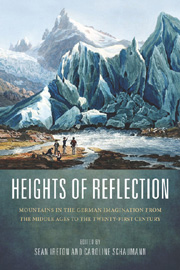 Heights of Reflection
Heights of Reflection Book contents
- Frontmatter
- Contents
- Acknowledgments
- Introduction: The Meaning of Mountains: Geology, History, Culture
- Prelude: Classical Mountain Landscapes and the Language of Ascent
- Part I First Forays: Mountain Exploration and Celebration from the Middle Ages to the Eighteenth Century
- Terra Incognita? Mountains in Medieval and Early Modern German Literature
- From Meadows to Mountaintops: Albrecht von Haller's “Die Alpen”
- Interlude: Geo-Poetics: The Alpine Sublime in Art and Literature, 1779–1860
- Time and Narrative in the Mountain Sublime around 1800
- Faust's Mountains: An Ecocritical Reading of Goethe's Tragedy and Science
- Spectacular Scenery and Slippery Descents: Narrating the Mountains of Tropical Polynesia
- Part II Beckoning Heights: Summits Near and Far in the Nineteenth Century
- Part III Modern Expeditions and Evocations: Climbing from the Twentieth into the Twenty-First Century
- Works Cited
- Notes on the Contributors
- Index
From Meadows to Mountaintops: Albrecht von Haller's “Die Alpen”
from Part I - First Forays: Mountain Exploration and Celebration from the Middle Ages to the Eighteenth Century
Published online by Cambridge University Press: 05 February 2013
- Frontmatter
- Contents
- Acknowledgments
- Introduction: The Meaning of Mountains: Geology, History, Culture
- Prelude: Classical Mountain Landscapes and the Language of Ascent
- Part I First Forays: Mountain Exploration and Celebration from the Middle Ages to the Eighteenth Century
- Terra Incognita? Mountains in Medieval and Early Modern German Literature
- From Meadows to Mountaintops: Albrecht von Haller's “Die Alpen”
- Interlude: Geo-Poetics: The Alpine Sublime in Art and Literature, 1779–1860
- Time and Narrative in the Mountain Sublime around 1800
- Faust's Mountains: An Ecocritical Reading of Goethe's Tragedy and Science
- Spectacular Scenery and Slippery Descents: Narrating the Mountains of Tropical Polynesia
- Part II Beckoning Heights: Summits Near and Far in the Nineteenth Century
- Part III Modern Expeditions and Evocations: Climbing from the Twentieth into the Twenty-First Century
- Works Cited
- Notes on the Contributors
- Index
Summary
In 1732 the anonymous poem “Die Alpen” was published along with nine other poems in a slim volume entitled the Versuch Schweizerischer Gedichten (Attempt at Swiss poems). Written in German and crafted in 490 alexandrine verses, the elaborate poem already had some impact in its handwritten form, after Haller had written the piece in March 1729, drawing on the impressions of his trip through Switzerland with his friend Johannes Gessner. After its publication, however, the work enjoyed immediate success with the intellectual elite. A second edition appeared in 1734, issued this time under Haller's name; nine more editions followed during his lifetime, each featuring further revisions, commentary, and addenda (the final edition contained thirty-one poems). The volume was also translated into French, English, Italian, and Latin, making Haller famous as a poet even before he became a recognized scholar and scientist.
While “Die Alpen” builds on the works of Swiss naturalists and writers who had already collected vast knowledge about the region (Josias Simler, Johann Jakob Scheuchzer, and Beat Ludwig von Muralt), it represents a pivotal turn in the conception of the Alps insofar as Haller invokes the classical trope of the pastoral and extends it to the high peaks, introducing a discourse that had both immediately tangible and long-term paradigmatic effects. In contrast to earlier representations, Haller's poem endows the mountains with moral qualities, exuberantly celebrating the simple, rural life in preference to the decadence and turmoil that prevailed in courtly society.
- Type
- Chapter
- Information
- Heights of ReflectionMountains in the German Imagination from the Middle Ages to the Twenty-First Century, pp. 57 - 76Publisher: Boydell & BrewerPrint publication year: 2012


